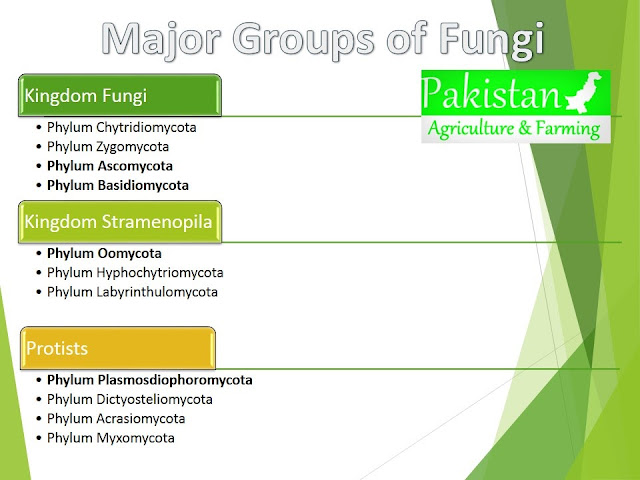 Fungi are small, generally microscopic, eukaryotic, usually filamentous, branched, spore-bearing organisms that lack chlorophyll. Fungi have cell walls that contain chitin and glucans (but no cellulose) as the skeletal components.
Fungi are small, generally microscopic, eukaryotic, usually filamentous, branched, spore-bearing organisms that lack chlorophyll. Fungi have cell walls that contain chitin and glucans (but no cellulose) as the skeletal components.What is Phylogenetic Classification?
A
classification based on the evolutionary relationships is known as Phylogenetic
classification.
IMPORTANCE
Although
classification can be done on the basis of any criteria but classifying on the
basis of phylogenetic relationships aid us
Ø in understanding the
evolutionary changes and
Ø allow one to make prediction
on the basis of what is known about an organism and its close relatives.
Traditional Classification
of Fungi
u In the 2 kingdom system of
classification, fungi were placed under kingdom Plantae.
Modern Classification
of Fungi
u According
to Hawksworth et al., 1995 and Alexopoulos and Mims, 1979:
The
organisms once considered fungi are now considered under three different
kingdoms.
1.
Kingdom
Fungi
2.
Kingdom
Stramenopila
3.
Kingdom
Protista
u This is due to classifying
organisms in monophyletic groups.
This
classification recognizes that the organisms which have been called “fungi” are
not closely related.
 |
| Classification of groups of organisms which were once considered as 'Fungi' |
What is monophyletic and polyphyletic grouping?
u A monophyletic group consists
of an ancestor and all its descendents.
u Polyphletic groups do not share a close common
ancestor.
NOMENCLATURE OF FUNGI
u All the activities of
nomenclature of fungi fall under the rules of International Code of
Botanical Nomenclature (ICBN).
u The “Biological Code” now makes
it clear that it includes all the groups that have been traditionally
considered as plants.
COMMITTEE OF FUNGI
u At each International Botanical
Congress (held every four years) a Committee for Fungi is formed.
FUNCITONS:
u To make recommendations on
proposals to conserve or reject names and
u To comment on changes being
considered in the rules relating to fungal nomenclature.
u When modification of the
existing code are approved at the congress, the code is updated.
Rule of PRIORITY
Priority
is the provision of the code that helps to determine the correct name for a
taxon. For example;
- If a single species is
described by two mycologists; then the species described first is said to
have priority and accepted as the correct one.
- Sometimes the description
of a new taxon is unknown to a second worker because both publications are
in press in two different journals.
In
such case, the exact date of issue of the journal is important in determining
priority.
Confusion of Anamorphs
& Telomorphs Nomenclature
Fungi
may exist in many forms (=morphs), that is, they are Pleomorphic. The
existence of different morphs in the life cycles of fungi has nomenclature
significance since this lead to different names for the same fungus. Later on,
genetic connection was established between sexual and asexual forms. But
anamorphic names are still common.
 Telemorph
Telemorph
u Greek, teleos = perfect,
entire; morphe = form
u The morph which include the
sexually produced spore form is called telomorph. Previously known as perfect
stage of fungus.
u For example; Ascocarps of ascomycetes and basidiocarps
of basidiomycetes.
Anamorph
u Greek, ana =
similar to, thorough out
u The asexual morphs are called
anamorphs.
Or
u The asexual stage of fungal
life cycle is called anamorph.
u Previously known as Imperfect
stage of fugus.
u This characteristic of fungi
lead to the formation of group of fungi called “Fungi Imperfecti” or “Deuteromycetes”.
u This group only contains fungi
which reproduce asexually and have no sexual stage reported.
The CONFUSION…!
u In some cases anamorphic names
are very common and telomorphic names are not.
For example; Aspergillus
nidulans is name for conidial stage (Anamorph)
of same fungus but Emericella nidulans is name for
ascocarp stage (telemorph).
